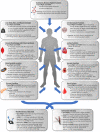Implementation of exercise countermeasures during spaceflight and microgravity analogue studies: Developing countermeasure protocols for bedrest in older adults (BROA)
- PMID: 36017336
- PMCID: PMC9395735
- DOI: 10.3389/fphys.2022.928313
Implementation of exercise countermeasures during spaceflight and microgravity analogue studies: Developing countermeasure protocols for bedrest in older adults (BROA)
Abstract
Significant progress has been made in the development of countermeasures to attenuate the negative consequences of prolonged exposure to microgravity on astronauts' bodies. Deconditioning of several organ systems during flight includes losses to cardiorespiratory fitness, muscle mass, bone density and strength. Similar deconditioning also occurs during prolonged bedrest; any protracted time immobile or inactive, especially for unwell older adults (e.g., confined to hospital beds), can lead to similar detrimental health consequences. Due to limitations in physiological research in space, the six-degree head-down tilt bedrest protocol was developed as ground-based analogue to spaceflight. A variety of exercise countermeasures have been tested as interventions to limit detrimental changes and physiological deconditioning of the musculoskeletal and cardiovascular systems. The Canadian Institutes of Health Research and the Canadian Space Agency recently provided funding for research focused on Understanding the Health Impact of Inactivity to study the efficacy of exercise countermeasures in a 14-day randomized clinical trial of six-degree head-down tilt bedrest study in older adults aged 55-65 years old (BROA). Here we will describe the development of a multi-modality countermeasure protocol for the BROA campaign that includes upper- and lower-body resistance exercise and head-down tilt cycle ergometry (high-intensity interval and continuous aerobic exercise training). We provide reasoning for the choice of these modalities following review of the latest available information on exercise as a countermeasure for inactivity and spaceflight-related deconditioning. In summary, this paper sets out to review up-to-date exercise countermeasure research from spaceflight and head-down bedrest studies, whilst providing support for the proposed research countermeasure protocols developed for the bedrest study in older adults.
Keywords: aging; bedrest; cardiovascular; exercise countermeasures; musculoskeletal; spaceflight.
Copyright © 2022 Hedge, Patterson, Mastrandrea, Sonjak, Hajj-Boutros, Faust, Morais and Hughson.
Conflict of interest statement
The authors declare that the research was conducted in the absence of any commercial or financial relationships that could be construed as a potential conflict of interest.
Figures


References
-
- Abdullah S. M., Hastings J. L., Shibata S., Platts S. H., Hamilton D. R., Thomas J. D., et al. (2018). Effects of prolonged space flight on cardiac structure and function. Circulation 128, A18672.
-
- Alexandrov A., Gharib C., Grigoriev A. I., Güell A., Kojarinov Y., Ruvinova L., et al. (1985). Oral glucose tolerance tests in man during a 150-day space flight (Salyut 7-Soyuz T9). C. R. Seances Soc. Biol. Fil. 179, 192–195. - PubMed
Publication types
LinkOut - more resources
Full Text Sources

